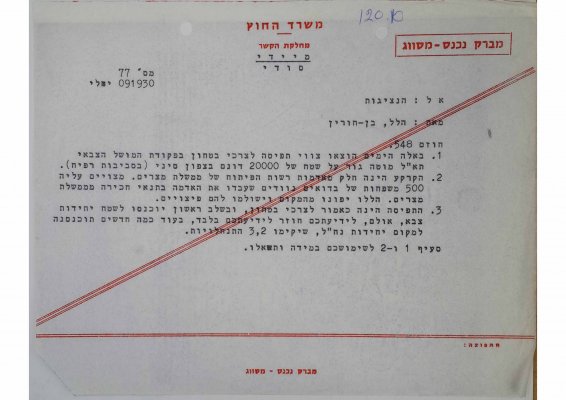The practice of taking over Palestinian land on security pretexts and then building Israeli settlements on it is familiar mostly from the West Bank. A short document demonstrates how Israel used the same method in the Sinai Desert as well.
The “Rafah Salient” affair, which began in January 1972, was entirely secret at the time. It involved the displacement of thousands of Bedouin who lived in the northeastern Sinai Desert. Their homes, fields and orchards were destroyed by the army secretly, out of the public eye. The expulsion and destruction were meant to clear the way to take over land in the area, soon to be renamed Yamit District, and prepare it for building Israeli settlements. Officially, and in a response to a High Court petition the Bedouin residents filed against their displacement, the State claimed it needed the land for security purposes, namely, creating a buffer zone between the Gaza Strip and the Sinai Desert to put an end to hostile activity in the Strip and the northern Sinai. The court accepted the State’s petition and rejected (Hebrew) the residents’ petition.
Years after the judgment, historian Gershom Gorenberg uncovered a secret report by a military commission of inquiry that looked into the expulsion of these Bedouin residents. The report showed that there never was a security reason for the expulsion and mentioned no security considerations that guided the military in its actions in the Rafah Salient.
A secret cable from July 1969, about two and a half years prior to the expulsion of the Bedouins by the military, proves the Ministry of Foreign Affairs was well aware of the reason for the violent, brutal landgrab in Rafah Salient: The true objective of the expulsion was the construction of civilian settlements. The cable, posted here, was sent on July 9, by the two deputy director generals of the Ministry of Foreign Affairs at the time, Shlomo Hillel and Elyashiv Ben Horin, to foreign ministry missions. It apprises foreign ministry representatives that in recent days the military governor had issued security seizure orders for 20,000 dunams around Rafah in the northern Sinai Desert. The cable further states the land was not registered as privately owned, but was rather located in an area that belonged to the Egyptian government’s development authority, and cultivated by some 500 Bedouin families working as tenant farmers. “They,” the letter stated laconically, “will be removed from the area and receive compensation.”
The cable authors added a demand that foreign ministry missions refrain from revealing the true reason for the expropriation: “The seizure, as stated, is for security purposes, and initially, military units will be brought into the area. However, for your information [,] repeat, for your information only, in several months, Nachal units will be brought in to establish 2-3 settlements” (emphasis added by Akevot Institute). As stated, the plan was fully implemented just a few years later.


